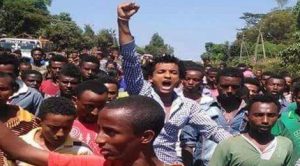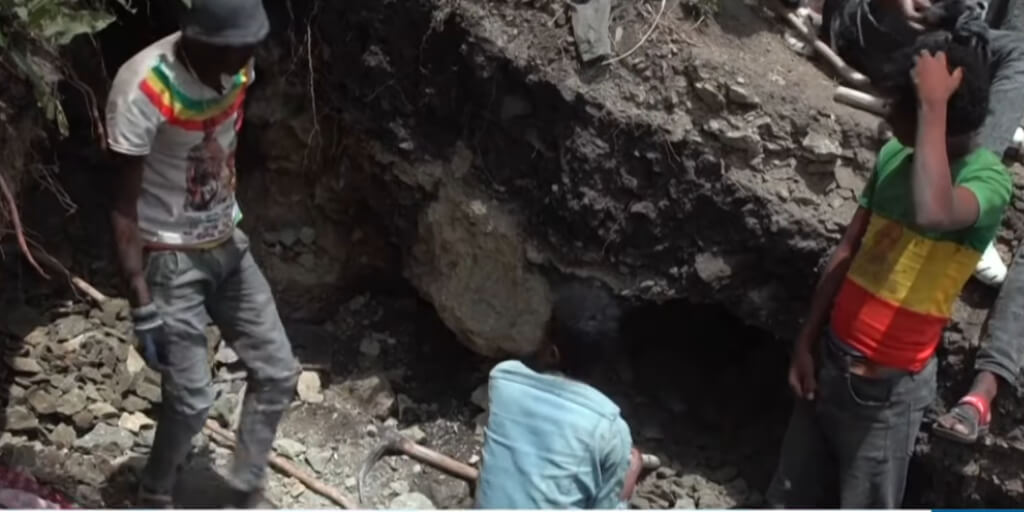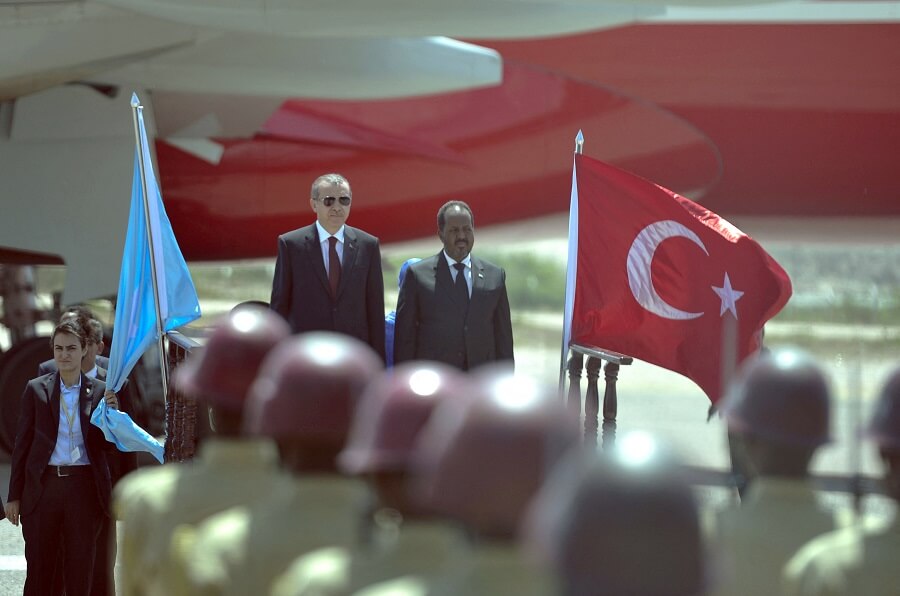Oromo protests: defiance amidst pain and suffering
Ginchi, Ambo, Adama and Woliso
Mahlet Fasil and Tsedale Lemma
It all began on No 12th in Ginchi, a small town some 80 Kms South West of the Capital Addis Abeba. It is a town of not more than 50, 000 inhabitants, “95% of whom are Oromos”, a nation whose ethnic makeup is known to represent more than 35% of Ethiopia’s 90 million plus diverse population.
But as far as the story of township significance (for Ethiopia) goes by, Ginichi is the last town anyone could think of. It’s a sleepy town; but it’s surrounded by serine farmlands and a breathtaking forest reserve in and around the small hills on the outskirts of the town. Most of its communities are farmers with some small time traders who run the center of the town.
That status, however, may have changed on a sunny Sunday of Nov. 12th when a group of young (and some old) residents of the town confronted a government inspecting team of not more than “half a dozen,” according to a young grocery owner in the area. Residents suspect the officials were there to push though deals to transfer a nearby field used by local youngsters as Sunday football pitch and clear a forest reserve for an upcoming investment project. Officials from the Oromiya regional state, to which Ginchi belongs to, and the central government deny any of this happening. But it was too late to stop scenes of extraordinary defiance and students-led protest that started from Ginchi and spread throughout the country for the last four weeks.
Reason? It was no longer the football pitch and the forest residents of Ginchi say they would protect at any cost; it was the Addis Abeba city hall’s ambitious (if ill-fated) plan – ‘Addis Abeba and the Surrounding Oromia Special Zone Integrated Development Plan’. Known in short the “Addis Abeba Master Plan”, federal authorities say it is merely aimed at creating an economically integrated Addis Abeba with six of its surrounding localities currently under the special administration of the Oromiya regional state.
The four weeks that since ensued have seen protests (most of them led by elementary and high school students, but also joined by University students in cities where university campuses are available) spread like bushfire. Geographically, all protests are happening throughout the Oromiya regional state, the largest of the nine states that makeup Ethiopia. Commenting on the domino effect of the small protest in Ginchi, the young grocery owner said: “never in my lifetime could I imagine this.”
It’s a statement many could agree with, but not the protestors.
Ambo was next
A university city just over 30 km before Ginchi, and 120 kms west of Addis Abeba, Ambo, a three hrs drive from Addis Abeba, is the bedrock of Oromo opposition politicians such as the renowned Prof. Merera Gudina and their constituency. Going by a recent past, similar Oromo students’ protests in April and May 2014 saw the highest death toll per city and a fierce crackdown by government security personnel that also saw the arrest of several protesting university students. Oromo activists say more than 60 protestors were gunned down during the two month 2014 protest; the government’s own account put the death toll at just 11.
The current protest at Ambo University began barely a week after the small protests in Ginchi that went largely peaceful. Students at the university were having their dinner at the compass’s cafeteria when power went off – not an unusual incident. But the week was preceded by news from Ginchi and several indications that the federal government, which temporarily put off the implementation of the Addis Abeba Master Plan in the aftermath of the April 2014 protest (and said it was doing so to ensure greater public participation), was bent on proceeding with the implementation.
Once darkness fell, students began throwing their cutlery and started chanting “Say No to the Master Plan”, a slogan recently adopted by social media activists. A few minutes later, the cafeteria was surrounded by campus police who agreed with the students that they can have their grievances peacefully staged the next morning, according to Workinesh Hinsarmu, who works at the university. But that ‘hold it until morning’ promise was not to come; the next morning the compound was heavily surrounded by not only the regional police but also the federal police forces.
“On a Monday morning at 8:30 we moved out from our dormitories to start our peaceful demonstration but about five federal police officers approached us and told us to stop. We continued shouting our slogans. By this time other group of the federal police came and took three of our friends and started kicking them violently,” remembers Gudeta, a third year student who only wanted to be mentioned by his given name. The situation escalated when hundreds of students ran to their dormitories and (“mostly federal”) police pursued after them. “They went from dormitories to dormitories and captured many of us – even those who didn’t participate in the rally.” Gudeta recounted of the violent physical assault by the police including “an order for us to stare at the blazing sun for nearly 40 minutes.”
Gudeta says many elementary and high schools in the city were already closed by the time the university students tried their chance to protest against the so called Master Plan. The university administration put up an emergency notice calling for the resumption of class as of the next morning. But the students demanded the withdrawal of the police and federal security personnel from campus. A senior administrative official told us “the police were here to stay for six months, or even a year and half if necessary,” Gudeta said.
Caught in the crossfire is Abel Tamrat, a 2nd year student who wasn’t planning to participate in the protest rally but was taken from his dorm during police’s search for those who ran away from the aborted rally. “All I wanted was to sleep in my bed, but they broke into our dorm and took me and started beating me. I tried to tell them I wasn’t a part of the protest rally, but no one was listening. Instead one of them started beating me on my face with his gun’s butt. Next thing I know I am at a hospital missing four of my front teeth.” Abel tells of a disturbing scene at the hospital, where the doctors and nurses were soaked in tears and despair to attend their patients. “We were many.”
The iconic photo that became the face of the ongoing Oromo protests (Photo: Social media)
The whereabouts of several other university students is not known. Both Abel and Gudata told Addis Standard (often looking at their shoulders and still scared) that they are frantically trying to locate their missing friends.
Students from other cities in the country are the hardest hit. Sheltered at an Orthodox Church, around 50 students who were even scared of showing their faces told Addis Standard’s reporter Mahlet Fasil that they can’t leave the town for lack of money and police’s control in the city exists. Upon checks on busses leaving town anyone with a student ID is haunted and returned back to the city. All of them say they couldn’t withdraw the money their parents have sent them from different banks operating in the city. Berka Gudata, a bank employee, confirmed their story. “We have no network in the bank. They ask as to help them, but there is nothing we can do.”
In the last three weeks Ambo and its surrounding turned itself into a hot spot of protest when residents from several villages surrounding the city joined students to express their anger both at the violent way the security personnel dealt with the protestors and the fundamental question – the Master Plan. In follow up calls (when available) with eye witnesses in the city, people tell of the death of protesters at the hands of the police (no accurate figures are available); and last Saturday a grenade exploded near Abebech Hotel in the center of the town. No causality was reported. Security officers patrolling the town are extremely vigilant; they routinely stop individuals on the street (as was the case with our reporter Mahlet Fasil, who was stopped from taking pictures and was told by a plain clothed security officer that she looked “a stranger and should go back to where you came from as soon as possible.”)
The southern part of Ambo, off the rough road leading to Wonchi Creator Lake and further south to Woliso town (administratively known as South-west Shewa zones) in local areas such as Ameya and Geldu news that both regional and federal police have lost control of the villages is rife. Lemma Gaddisa, an eye witness describes “carnage, looting and vandalism committed both by security officers and people who are total strangers to the area.” “The people in the area have destroyed roads leading to villages to prevent security officers entering the villages,” Lemma said on the phone.
Further afield to the north of Ambo in an area called Ginde Beret, another eye witness who is sheltering at relatives in Ambo town and says he is wanted by the police for helping print banners told Addis Standard he has seen a fierce battle between residents and the police. “I saw many people shot and lying on the road.” He also talked of “ransacked government offices, cadres badly beaten and cars and tyres burned on the street.”
Woliso
Accessible both from Ambo and the capital Addis Abeba, Woliso is located some 200 kms west of Addis Abeba. Previously unknown as a city of protest, Woliso serves as the center of trade between Addis Abeba and Jimma, another major town in the Oromiya regional state some 360kms west of Addis Abeba. But on Wednesday Nov. 25th Woliso witnessed what some of its residents said was an “unprecedented standoff between residents and the regional and federal police” when security agents started to randomly detain students and young people on the streets. The town’s people then got news from Ambo and its surrounding and connected the dots on why their children were being preemptively picked up by security forces. Hundreds of students have gathered and started shouting “stop killing our brothers,” said Dirbe Arega, a long time resident of the town and a mother of five. “Soon the shooting began. I ran to the middle of it because two of my five children aged 13 and 15 were on their way from school.” Dirbe said already in mid-morning after she saw an unusual deployment of security forces she went to the school and took three of her younger children from an elementary school not far from her house. “I have lived in this town for nearly 30 years but I have never seen anything like this.”
Four nearly four days between Nov. 25th – 30th Woliso was isolated (for a better part of the days) from both roads leading to Jimma and Addis Abeba. The extraordinary scenes of defiance started unfolding when protestors returned to the streets on Friday Dec. 11th. “This time, protestors came with piles of tyres to keep the police away and set them on fire,” a young student attending training as tailor for school leaving girls told Addis Standard. She is attending the training at a project financially supported by a government micro financing scheme, but she got the chance only after she was registered as a member of the ruling party. “Many young people went to the micro finance office and have tried to set it on fire. They are angry because not everyone is lucky enough to receive support.” She says as the week went by the question of the Oromo students protesting was no longer the Addis Abeba Master Plan, but “a better opportunity for all of them.”
Pictures allegedly sent by the protestors and were posted by activities on social media show two dead young men lying on the street. After the Friday’s shooting the biggest hospital in the town, St. Luck Catholic Hospital, was overstretched “beyond its capacity,” a worried nurse told Addis Standard on the phone. The road to the hospital was blocked by security officers who were busy preventing relatives from coming into hospitals. With news of road blockades on the road to Addis Abeba, virtually every business closed and a scene of utter chaos on the streets, Woliso, a town of lodges and several hotels known for many tourists, felt no more safe. Follow up phone calls confirm the town as slowly returning to normal, but a it remains tense and apprehensive.
Adama
A bustling city 100 km south of Addis Abeba, Adama is the second most important administrative city next to Addis Abeba. It was once made to become the capital of the Oromiya regional state, a politically toxic decision that cost the lives of unaccounted numbers of Oromo university students in the hands of security forces during a protest in 2001 against the decision. Since then, Adama is “under the vigilant supervision of the federal government,” says a professor at the Adama Science and Technology University, the largest of its kind.
Oromo protests at the university began the last week of November. It started with the students demanding the University for the withdrawal of the increasing numbers of federal and regional police forces from the compound. According to a civilian security of the campus gate, who wishes to remain anonymous, the police became suspicious about the demands and started checking the students thoroughly upon leaving and coming in to the compass. That set off the protest.
But instead of the usual confrontation between unarmed students and police officers armed to the teeth, the students did an unexpected display of solidarity with Oromo student protestors, by now happening in more than 50 cities, according to campaigners and activists. More than 600 students at the Adama Science and Technology University gathered at the canteen for lunch and received their lunches but left every single plate of it untouched.
The ongoing Oromo protests have not all been voilence. Symbolic peaceful protestes like shown here have spread widely (Photo: Social media)
It became an act of solidarity widely repeated around several university campuses including here at the Addis Abeba University main campus.
But that peaceful display of solidarity didn’t spare the students from gun shots. Hana who works in the administrative department of the campus and wanted to be called by her given name only, told Addis Standard that she heard “guns being fired at around freshmen dormitories.” For the next three days, the campus was a scene of despair and chaos, but also persistent protest. Although the protests didn’t spread to the town, many students were “wounded by bullets”, according to Nahom Endale, a 3rd year marketing student; many have also left the campus; it is unclear who will show up and who will not when this is over.
Molla Yerga, a father from Gondar who came to pick his son spoke with Addis Standard with utter sense of despair: “I couldn’t find my son. When he called me to tell me there was a problem at the campus, I warned him to stay in his dorm but he is not there. All his friends told me they haven’t seen him.” Molla said his son’s cell phone is also switched off. “I trusted the safety of my son to the government when he came to study at the campus, now my son is missing. It is a shame.”
On Dec. 5th evening the federal anti-terrorism task force issued an alarming statement labeling persistent protests as attempts of terrorism and indicating that the task force will do everything necessary to bring law and order in some areas. In other words, there is “more death to come,” said Gonfa Abera, a student at Ambo University but who is staying here in Addis.
The protests have spread to more than 80 cities and the opposition, Oromo Federalist Congress (OFC), says more than 50 protestors have so far been gunned down by the police and more than 500 arrested. The government puts the number of death at just five and maintains the protests are happening in “few areas by a few individuals.”
But as of the publishing of this news, information coming from social media activists (supported by still pictures, videos and audios) show defiant protests happening in cities in Oromiya regional state from east to west, south to south east of the country.
Ed’s note: For security reasons and because our interviewees requested Addis Standard did not take its own pictures of neither the areas visited, not the people interviewed. All the pictures used in this story are taken from social media
Related links:
A new master plan: Complicated-turned-deadly
Why resist the Addis Abeba Master Plan? – A constitutional legal exploration









